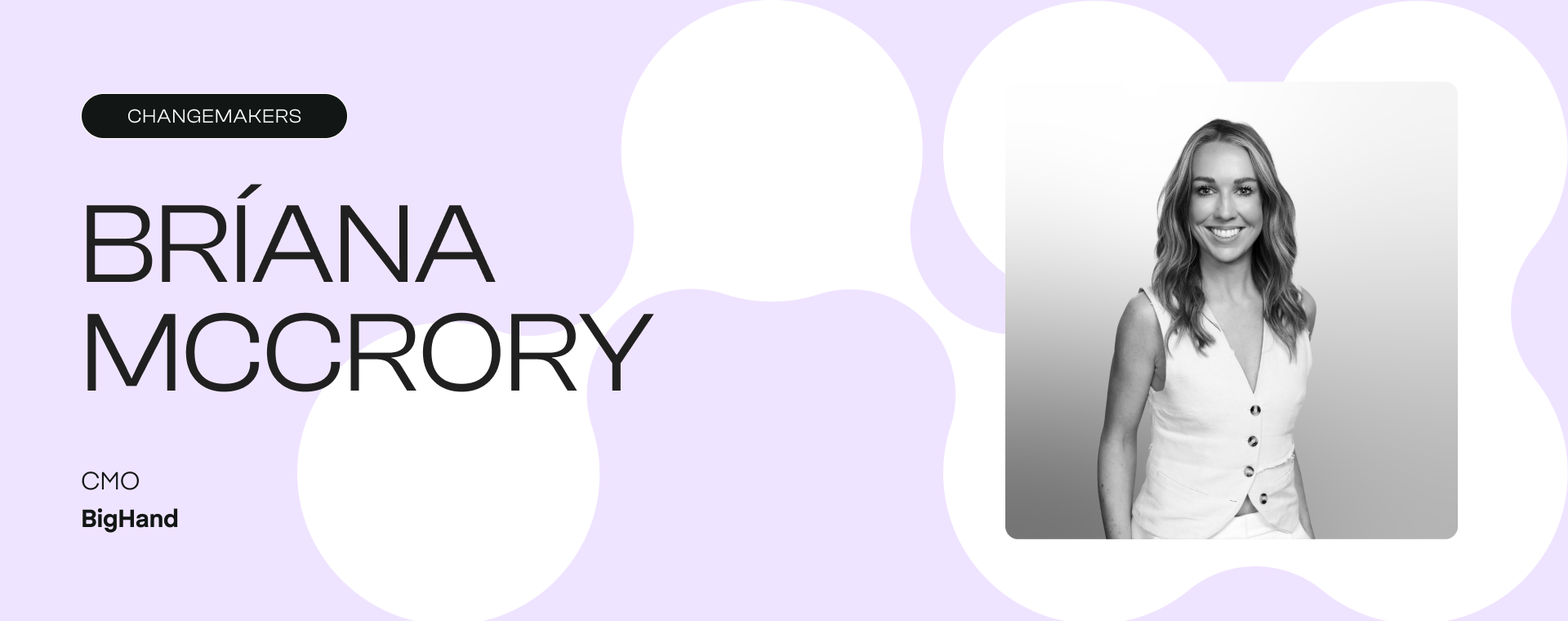From cost centre to growth driver: BigHand CMO Bríana McCrory on redefining marketing’s role
Legal tech CMO shares how she’s shifted marketing from support function to growth engine, through accountability, data-driven storytelling and a culture of change.

Tell us about yourself.
My name is Brí McCrory and I’m the Chief Marketing Officer at BigHand. I have been at BigHand for 12 years, and my mission is to make marketing indispensable to the business by directly driving revenue growth, switching marketing from being a cost centre to a revenue driver. That means aligning every campaign to the business strategy, proving and understanding the commercial impact of marketing, ensuring our brand is trusted by our clients and partners and the wider sector we work in.Really focusing on the success and ultimate profitability of both our customers and our business. For me, marketing isn't just a support function, it's the growth engine. I’m determined to ensure that within my remit at BigHand, marketing is the growth engine – and that, more broadly, the profession of marketing itself is viewed the same way…as a driving force for business performance and transformation.
How do you see your role as a marketer in driving broader industry or sector change within your space?
I think marketing’s role is to shape industries, not just support sales. That means owning the narrative across the entire buying cycle. In most B2B enterprise deals, especially in tech, there are between seven and twelve stakeholders involved in the decision-making process, and we need to understand all of them.
Although BigHand has been around for 30 years, our products sit at different lifecycle stages, and we’ve often been first to market. That’s meant creating awareness of the problem before we could even position the solution, which really highlight the value of marketing in shaping both the industry and how our clients work.
Every complex B2B decision involves multiple stakeholders with different success criteria, demographics, and expectations. The role of marketing is to ensure each of them understands why the issue matters and the role they play in solving it. In legal, for example, that might mean showing a CFO how profitability is at risk, while making the same case relatable to a pricing director or lawyer under client pressure for costs and a managing partner focused on growth.
If you look at today’s buying process, there are now five generations involved. We have to understand the challenges each of them face and make sure our marketing addresses those needs, while still tying back to the overall solution. We use the full marketing mix, but we’ve invested heavily in research to set the agenda and then built storytelling around it. This ensures we have relatability, urgency and the data stakeholders need to continue the conversation internally. Our job isn’t just to tell the story; it’s to make sure it can’t be ignored.
Each generation requires something different. For us, 57% of buyers are Millennials, and they want a very different relationship. They care about trust, people and relationships (and how this will benefit ‘me’), because whoever signs the contract is putting their own job on the line, and we need to make them the hero of the story. The generation before them looked for proof: a trusted brand, features, functionality, the tech. The generation after, more Gen Z, often at a user or influencer level, want information and access quickly so they can make their own decisions. Up to 80% of the buying journey is done before they’re ready to speak to sales. As a marketer, it is my job to understand and drive those engagements before sales involvement, and then to support sales in that crucial final part!
What's the most provocative idea or strategy you've implemented in your b2b marketing, and what was the response?
Honestly, I’ve struggled with this because I don’t think there’s been one really provocative, defining idea. That might be the sector (legal tech) or B2B in general – there aren’t many silver bullets. We’re constantly testing and learning. I’ve built a culture where test-and-learn is a big part of what we do, usually focused on incremental gains rather than big transformational leaps. We’ve tried different ABM approaches, some very successfully, some very not! Marketing rarely has a black-and-white “right answer”. Everyone’s a consumer of marketing, so everyone’s an expert, so you just have to lean into that and try different things.
We’ve had a few campaigns that didn’t quite land, but that’s the point. About five or six years ago we had a piece of content we wanted to back with a joined-up campaign targeting CFOs for our BI solution: “You have 99 problems – but is your cash flow one?” We thought it was brilliant. The data told us…our CFO audience didn’t. Perhaps they weren’t Millennials, and it just didn’t resonate….or are not Jay Z fans! A few people who knew us well thought it was funny, but it didn’t deliver the pipeline engagement we were targeting. The learning was that we can push the boundaries a bit, track the response and if it doesn’t go right, the world won’t fall apart.
During COVID, we ran an ABM campaign linking gifting with product engagement to bring features and functionality to life through a cocktail kit. We linked the value of each part of the cocktail kit to the value of a different feature of one of our products e.g. The mixer, which brings together all the ingredients, was like our data warehouse gathering data from lots of different sources! The more you engaged, the more parts of the cocktail set we sent, so by the end you had the full kit and ingredients. The final part was the recipe of how to make it, again linking to the importance of training/onboarding with new tech. I still think it wasn’t a bad idea, but the ROI versus effort wasn’t there. Plus, it was a time when people were being inundated with home deliveries and fun zoom activities from vendors. Perhaps, right idea, wrong timing and audience – but still good to test. We learned a lot about process and how to streamline it. And I now have an open role for an ABM specialist, and I’m excited to test and learn in that way again.
Against the things that haven’t quite worked out, we have a lot that have! And the data behind it all to learn and grow! As I say to my team, when I am encouraging bringing new ideas and trying new things, we aren’t saving lives in legal tech marketing – go for it!
Broadly, I’m not sure there is “one” provocative way in B2B. It’s more about a relentless focus on marginal gains.
Broadly, I’m not sure there is “one” provocative way in B2B. It’s more about a relentless focus on marginal gains. If everyone involved in marketing looks for that extra 1% incremental win each time, you end up with huge improvements. We do that constantly — from a form landing page through to major campaigns. And we have built a data-culture so everyone is fully set up to track and identify those gains across everything they do! On top of that, we look for ways to get 10% more value from what we’re already doing. As teams become more specialised, people can end up working in silos. I have content, product marketing, brand, demand gen & ops. To drive collaboration we ask: what’s the 10% extra value we can get from your efforts? if you’ve got a great piece of content, how can demand gen use it more? If we’re going to an event, can we build content out of it or have an add-on event, or tie it in with a launch? How do we squeeze more value across functions? The 10% extra value more often than not, is also not 10% extra effort so it really is all about maximising the effort already put in to get the most value!
But if I consider everything we have done and the progress we have made, I think data-driven marketing is probably the most provocative change of the last five years. We now have so much access to data. Understanding it and using it to drive outcomes and performance has been the biggest shift. As a leader, it is incredibly rewarding that we are now in a place of reporting outcomes from activities with real-data, linking to strategic business objectives, in real-time. This change in having a data-driven mindset and approach to marketing has been the most impactful change and has been the driver of continued investment in marketing from our investors and our board.
Can you share an example of how you've used storytelling to shift perceptions in your industry?
For me, storytelling isn’t just about content; it’s about connection. We might call it B2B, but really it’s H2H – human to human. Connecting with everyone in the buying journey means understanding the different demographics, the emotions behind them, and how we align their expectations with ours through storytelling. It’s about keeping it relevant and relatable so every stakeholder can see themselves in the story.
We invest heavily in market research, and it’s become one of our most powerful storytelling tools. We ask key ICPs the right questions, then produce reports. There’s always an overarching theme linked to what our technology helps to solve, but it’s also valuable industry data they can use. It’s now referenced in every client engagement and across the wider legal sector. We even hear our own data reported back to us at presentations. Recently, we discovered our main competitor uses it – and actually references us. Slightly strange, but we took it as a compliment! It proves the value of what we’re doing and shows the narrative is shaping the industry, not just our place in it.
We combine that research with real client stories – how they’ve tackled the issues and how oure product helps – to create tangible, practical solutions. We work to craft narratives that combine both operational and strategic, because the people you speak to day-to-day, who are solving real challenges, often aren’t equipped with the more strategic information for executive conversations to get the sign-off. We need to help them tell the story when we’re not in the room and at the core of every story, ensure the person who is tasked to solve the challenge within the law firm is the hero. How can we make their lives & contributions at work better!
Because we produce these reports regularly, we make sure each one focuses on sharp pain points. One of the key themes from the report we published in August was the Million Dollar Problem. It showed that if a law firm loses an associate, it can cost at least a million dollars to replace them. With margins under pressure and costs rising, are firms really thinking about retention strategies and minimising cost leakage by reframing the problem? That approach has driven huge engagement. People know there’s a lot of lateral movement in the sector, that generations have different loyalty levels, and that expectations from employers are changing. In the report, behind flagging awareness to the financial risk, we’ve also highlighted the different drivers and solutions to it, giving law firms the information and tools to act.
We’ve just released another report on pricing trends in law firms, with a similar positioning approach: moving from the “spreadsheet hero” into the “strategic leader,” giving finance professionals a role they aspire to. These data-led stories resonate differently across a buying team: a CFO hears risk, a partner hears growth, and a mid-manager sees career opportunity. We launched this while at a big Pricing event in the US and held a pre-release dinner an& discussion and the response (and discussion) was incredible. And in a few short weeks since launch, we have seen significant funnel movement from marketing into the sales pipe for our pricing technology.
Data is at the core of our storytelling, but it’s the combination with real-life examples that makes it relatable, actionable, and, when needed, strategic. And it is benefitting both our customers and our own business goals!
In your view, what do you think is the biggest change needed in b2b marketing right now?
Accountability. If marketing wants a seat at the table, we have to move away from reporting on vanity metrics like open rates and click-throughs. — they’re vital within the marketing function to optimise activity and roll up into the bigger picture. But at a strategic level, marketers need to think in revenue terms and track backwards from there.Too many marketers still treat them as measures of success and that keeps us in the cost-centre box. We now have more data than ever, and we need to use it to focus on what matters to the business: revenue-driving metrics such as deal velocity, value and volume, influence, acquisition cost, and, just as importantly, always looking at what we stop doing.
Marketing's number one target is revenue growth and retention. Sales might close it (and carry the burden of those numbers), but if we’re not passing enough opportunities through and enabling enough client engagement, that’s on us as much as it is on sales. That’s the top metric we track.
Within my team we use predictive forecasting for what’s needed at each stage of the funnel for every product, based on targets & close rates, to hit the number. We then operate on a rolling forecast of what we expect across our plans. Do the two always sync up? No. But knowing the benchmarks and forecast allows us to be proactive rather than reactive. And if something doesn’t go to plan, we own it, we don’t hide it. Marketing is subjective, and if you only own the wins, you lose credibility. Accountability underpins everything.
I’ve been fortunate to have a seat at our board table for some time, and at that level we don’t talk about marketing detail, we talk about revenue and outcomes. If things aren’t on track, marketing has to take its share of responsibility and not hide behind sales. The concept of one team has never been more important.
How do you encourage your team or organisation to think boldly and embrace change in their marketing approaches?
Change is a constant in my team, and embedding it as a positive has been key to our culture. Our vision is “tomorrow’s marketers today”. We constantly challenge ourselves to think and act differently, even after our most successful work, we still sit down and ask what we’d do differently next time – the incremental gains I spoke of earlier!
We describe ourselves as “dreamers and doers”: able to dream the impossible and then make it happen. I regularly adjust team structure, roles and responsibilities based on data from the buying journey, customer needs, shifts in the marketing landscape, our people’s skills, and the business priorities. That creates real opportunity if you’re willing to push boundaries and try new things. If something’s been done one way forever, it’s probably wrong now. I built a culture where it’s safe to fail fast but unacceptable not to learn. That growth mindset keeps us curious, open to inspiration from outside our industry, and always looking for marginal gains alongside bigger, bolder bets. Stay curious, keep learning, and back it up with data. Moving to a data-driven organisation has been transformational. There’s data at every level; the key is knowing what’s relevant to your role, how it feeds the bigger picture, and using it to test and learn.
On top of data, I place a big emphasis on two things – fun and being human! B2B (and lately the world as a whole) can be too serious. Bringing an element of fun and humanising what we do, not only aligns with our company brand, but it also makes a marketers job far more enjoyable and relatable to ‘the humans’ we are targeting!
Stay curious, keep learning, and back it up with data.
Linking to being human, having fun and trying new things, I also run a simple monthly challenge to get people thinking differently – it can vary from AI tools, to themed campaigns, to individual improvements etc. One month, I asked the team to come up with a social idea to engage their own generation, to really emphasise adapting our approaches to cater for the five different age demographics within our clients. Loads of ideas came through, and I let them run with it. One was based on a famous TikTok hippo, Moo Deng – I’d never heard of it (probably too old) so it was not my thing – but we pushed it out on LinkedIn and tied it to registrations for a webinar. A senior salesperson messaged me with concerns and a general message of: “We’re a serious business; this isn’t okay.” Instead of brushing it off, I explained the thinking: generational differences, the need to try new things, and the importance of standing out on LinkedIn, which is a high-converting channel for us and the importance of supporting my team in trying new things – test and learn in full mode! Regardless of the outcome, it was important I backed our decision to try it! However, by this time we did have data (because we track in real-time)! I showed the data. It turned out to be our most successful post in that campaign, not just on impressions and engagement, but in driving registrations. The sales rep thanked me for the context and admitted they’d remind themselves that change is good. I was a bit outside my comfort zone too, but I’d empowered the team, so we went with it.
We now see the industry doing more GIFs, animations and trend-led posts. One of our main competitors does it a lot. And that same sales rep who first pushed back is now fully on board. I even got a message recently: “Can you approve these memes?” I don’t want to spend my time approving memes, but those small things empower bigger-picture thinking and build a culture where change is seen as a strength, for people and for the organisation.
What do you think in one word makes b2b marketing changemaking?
I couldn’t narrow it down to one, so courage: to try new things and stand by them, even when you don’t get the results you want (but do set target results for everything)”.
And resilience: having the thick skin to take it on board feedback – you get more constructive than positive in marketing – because everyone is a consumer of marketing so everyone is an expert of it! But work through it, and remember it comes from a good place and you all have the same goals!
What is your one piece of advice to future change makers on how to be more effective in B2B marketing?
Be an expert in your business, not just in marketing. Know the strategy, the commercial goals, how the board measures success, what really matters to your clients, and the problems at an individual level. The more expert you are outside your own function, the more effective you can be within it.
Too often, marketers aren’t in the field, in the big meetings, or part of the wider discussions – they hear things second or third hand. Get in the room so you can ask the right questions in the moment. I spend a lot of time out in the field, and it baffles me how many marketers don’t or aren’t allowed. Sometimes it’s cost (a salesperson is given the seat instead) or marketing isn’t invited into strategic discussions. Push to be there.
Relationships are key. Nothing we do is in isolation. Build strong relationships so you can be curious, ask questions, and keep asking “So what?” What does it mean? What’s it telling us? What did we learn? You need those relationships to do it without it feeling like an interrogation, and the confidence to keep asking. And you need to combine curiosity with commercial focus so those questions (and answers) become a true value-add!
People still talk about the marketing–sales divide, but if everyone is aligned to shared outcomes, it disappears.
Finally, focus on outcomes. People still talk about the marketing–sales divide, but if everyone is aligned to shared outcomes, it lessens. Marketing shouldn’t be about recognition; if the outcomes are achieved, you’ve done a good job. We have the data to prove it, but it’s about sharing it with the right audience, in the right way, and being willing to give yourself a quiet pat on the back. That mindset shift - from “I did X” to “we achieved Y” – is what really matters.
In my team meetings I ask for priorities and outcomes, not to-do lists. What are we trying to achieve? Two and a half years ago, I tripled my team in a single quarter. That created a lot of change: established voices wanting to be heard, new people wanting to prove themselves. You need the right ways of working and strong relationships to keep everyone focused on the shared outcome. There will always be grey areas in marketing around who did what. The goal is to build relationships strong enough that everyone is bought into achieving the outcome we need.
But all of this relies on the wider business leaders also recognising the importance of joint outcomes and moving away from seeing marketing as a cost centre in the revenue group! If targets are being achieved it’s a joint win (but celebrated differently – sales must get the wider recognition) but more importantly, if targets aren’t being missed, then marketing needs to feel the pressure as sales do!
Changemakers spotlight innovative B2B marketing leaders who are driving industry transformation, where we explore bold strategies, disruptive ideas and the power of marketing. Meet more Changemakers here.
More Insights from alan.
To re-form your industry, we must re-form ours first. From our visceral point of view on creativity to our incisive approach to strategy, delve into our provocative thought-leadership on how we’re aiming to subvert B2B’s status quo.




